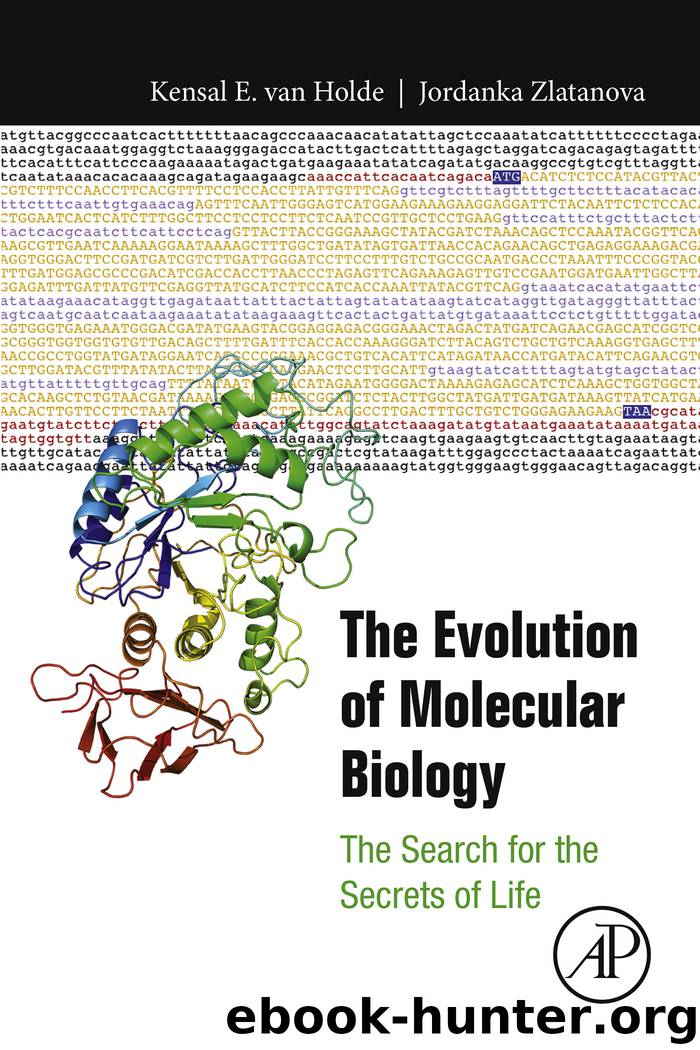The Evolution of Molecular Biology by Kensal Van Holde Jordanka Zlatanova & Jordanka Zlatanova

Author:Kensal Van Holde,Jordanka Zlatanova & Jordanka Zlatanova
Language: eng
Format: epub
ISBN: 9780128129180
Publisher: Elsevier Ltd.
Published: 2018-02-20T16:00:00+00:00
Fig. 12.4 The ovalbumin gene and its mRNA illustrate the concept of split genes.
The protein is 386 amino acids long and could have been encoded by a gene of 1158 bp, but the length of the gene is actually 7700 bp. This anomaly was explained when ovalbumin mRNA was purified from the cytoplasm, allowed to hybridize with the ovalbumin gene, and the resulting hybrid was examined under the EM (A). (B) In this schematic interpretation of the EM image, the black line shows the portion of the gene that does not have complementary representation in the mRNA (introns). The mRNA-DNA hybrid is presented as a gray line. (C) A linear presentation of the ovalbumin gene structure, with the 7 introns (A–G) in lighter gray and the 8 exons in darker gray. The gene is transcribed as a single long pre-mRNA, which is then processed to give rise to the mature mRNA that serves as the template in protein synthesis. (From Chambon, P., 1981. Scientific American, 245, 60–71, Fig. 1, with permission.)
Clearly, something special must take place in the eukaryotic nucleus to prepare mRNA molecules for translation on the ribosome—the introns still present in the primary transcript of the gene must be removed. In subsequent years, an elegant process of splicing was discovered. The gene, it turns out, is first completely transcribed, introns and all, to make a pre-mRNA. This is precisely cut and resealed to make a transcript containing only exon regions, in the proper order. After some further adjustments to the 5′- and 3′-ends, the mature message is delivered to the cytoplasm for translation. The signals as to where to cut and splice are all contained in the pre-RNA sequence.
An interesting twist to the splicing story was the discovery that one and the same pre-mRNA molecule can be spliced in a number of alternative pathways, giving rise to multiple mature mRNAs, and hence a number of alternative protein forms (e.g., see Fig. 12.5). In humans, ~ 95% of pre-mRNA molecules that are transcribed from split genes undergo alternative splicing. Hence, eukaryotes have evolved a complex and highly regulated splicing machineries and mechanisms to produce the protein forms needed by particular cell types. Interesting and highly significant analyses showed that > 60% of human disease-causing mutations affect the functioning of the splicing machineries, rather than the coding sequences themselves.
Download
This site does not store any files on its server. We only index and link to content provided by other sites. Please contact the content providers to delete copyright contents if any and email us, we'll remove relevant links or contents immediately.
| Cell Biology | Developmental Biology |
| Entomology | Marine Biology |
| Microbiology | Molecular Biology |
| Biostatistics |
Sapiens: A Brief History of Humankind by Yuval Noah Harari(13052)
The Tidewater Tales by John Barth(12029)
Do No Harm Stories of Life, Death and Brain Surgery by Henry Marsh(6336)
Mastermind: How to Think Like Sherlock Holmes by Maria Konnikova(6235)
The Thirst by Nesbo Jo(5785)
Why We Sleep: Unlocking the Power of Sleep and Dreams by Matthew Walker(5641)
Sapiens by Yuval Noah Harari(4536)
Life 3.0: Being Human in the Age of Artificial Intelligence by Tegmark Max(4507)
The Longevity Diet by Valter Longo(4445)
The Rules Do Not Apply by Ariel Levy(3905)
The Immortal Life of Henrietta Lacks by Rebecca Skloot(3826)
The Body: A Guide for Occupants by Bill Bryson(3800)
Why We Sleep by Matthew Walker(3771)
Animal Frequency by Melissa Alvarez(3755)
Yoga Anatomy by Kaminoff Leslie(3701)
Barron's AP Biology by Goldberg M.S. Deborah T(3631)
The Hacking of the American Mind by Robert H. Lustig(3579)
All Creatures Great and Small by James Herriot(3515)
Yoga Anatomy by Leslie Kaminoff & Amy Matthews(3395)
